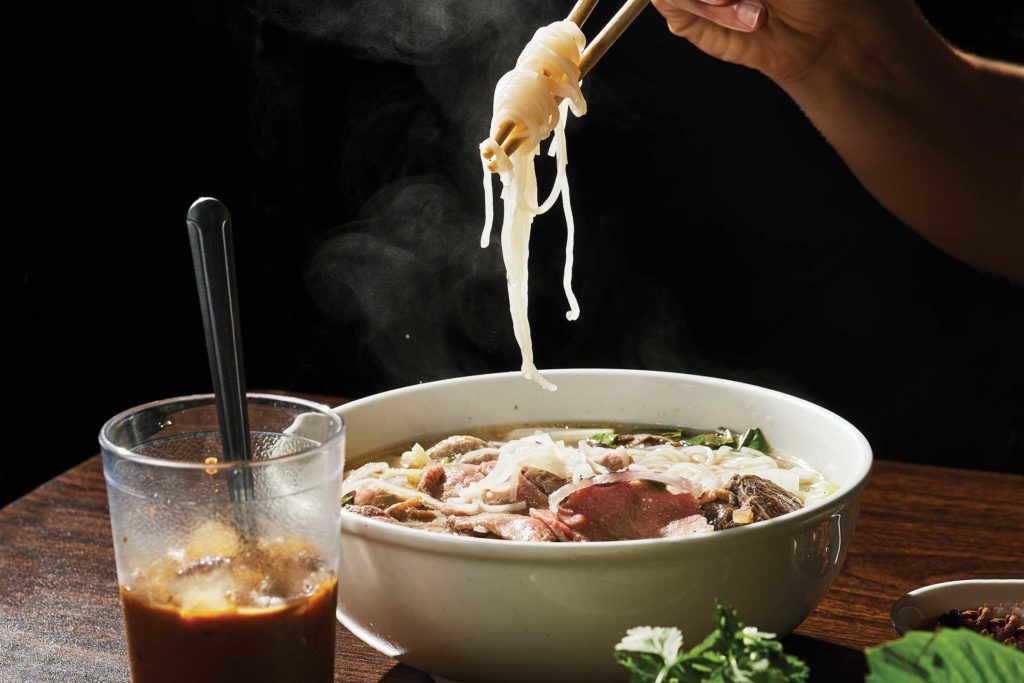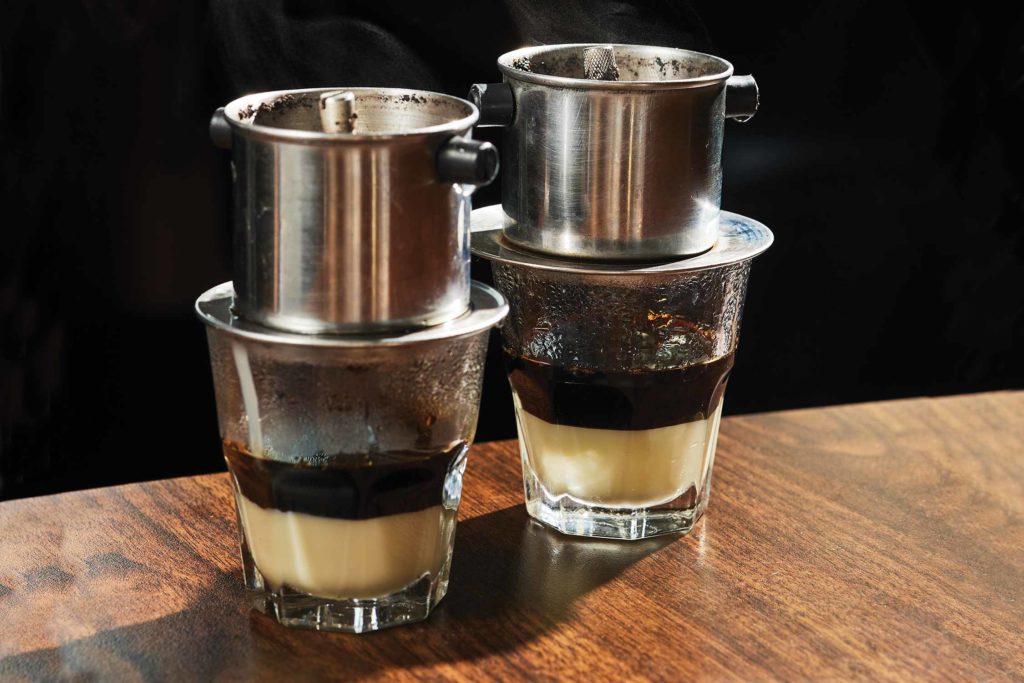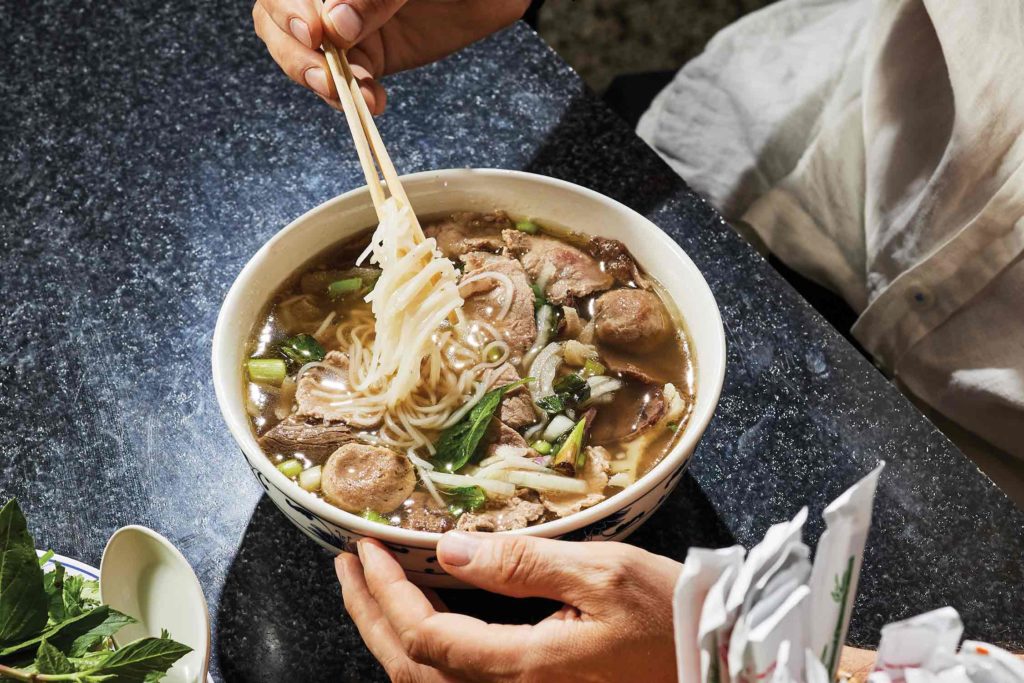When he was growing up in Saigon, Zen Nguyen’s typical breakfast was pho. He would walk to one of the food stalls in his neighborhood and pay the equivalent of twenty-five cents for a hot bowl of pho. Most shops would open at dawn and sell out by mid-morning. But that was almost two decades ago, Nguyen says. These days, a bowl of pho in Vietnam’s bustling former capital city will set you back about two dollars. As enterprising shop owners have noted the popularity of pho among the younger generation, plenty open back up for lunch or dinner.
A good bowl of pho bo—bone broth, thin-sliced ribeye, rice noodles and a pile of cilantro, basil and bean sprouts—is soul-affirming. Traditionally, street vendors would balance clay pots on each end of a long shoulder pole, catering to laborers who needed a nourishing start to their day. (You can still find a few elderly women who sell pho this way in Saigon, Nguyen says.)
In 2011, when he was eighteen years old, Nguyen emigrated to the United States, staying with family in Kansas City while he pursued a career in dance (Nguyen teaches hip-hop dance and does choreography). His relatives took him out to a local restaurant for a taste of home: pho. He could only manage a few bites. “It wasn’t good,” he says, shaking his head.
Nguyen missed the flavors of his home country, the way local ingredients tasted together. He also missed the ubiquitous street food: “Here, when you’re hungry and don’t want to cook, you order food at a restaurant,” he says, “but in Vietnam, you wake up and a food vendor comes to your door.” Each vendor has a unique bell so that hungry customers can hear their favorite hu tieu cart rounding the corner.
Compared to some of the creations Saigon’s street food artists offer, Nguyen doesn’t think pho is all that exciting. But it is, he says, one of the most important dishes in the cuisine—and it’s having a moment in Kansas City. Recent years have seen the arrival of a drive-thru pho spot in Johnson County and a counter-service pho eatery in a casino, both of which I tried over the last several weeks. I visited other pho places—nine total—and each bowl was wildly different from the next.
Pho is Vietnam’s national dish, but there is no consensus on what the perfect pho should taste like. Northern Vietnamese pho is nothing like southern Vietnamese pho, which is what most restaurants in the area serve. The answer to what makes a good pho varies as much as the answer to what makes a good cheeseburger.
The first name most people in KC mention is Vietnam Cafe in Columbus Park. Since husband-wife team Minh Hoang and Ngoc Le opened the shop seven years ago, it’s earned a reputation as the gold standard here. Its popularity necessitated a dining room expansion, which took place during the Covid-19 shutdown. Nguyen briefly worked at Vietnam Cafe years ago and ordered his favorites from Le in Vietnamese. Plates arrived in quick succession: banh xeo, tom cuon (addictive deep-fried shrimp rolls) and steaming bowls of pho and bo kho.
Banh xeo translates to “sizzling pancakes,” and they resemble omelets, but there is no egg—the folded golden crepe is a combination of rice flour batter, coconut milk and turmeric. At Vietnam Cafe, they’re stuffed with shrimp, sliced pork roll, raw white onions and bean sprouts. I mirrored Nguyen by breaking off a portion, rolling it into a lettuce leaf with fresh basil and dunking it into a bowl of fish sauce. It was a messy, unglamorous bite that nevertheless encapsulated everything that composes Vietnamese cuisine: meat, aromatic herbs, crisp vegetables and spices that linger on the tongue.

Our pho dac biet—pho ba on steroids, given its combination of thin-sliced ribeye, beef meatballs, brisket, flank and tripe—is also crowded with chopped white onions, scallions and thin rice noodles. The customary accoutrements are piled on an accompanying plate. But when it comes to pho, it’s the broth that matters most. I was distracted by a cacophony of cloves and star anise, which gave every sip a sweet and slightly bitter aftertaste, as though they had been added too early to the broth and lost their strength.

I said this to Nguyen, who shrugged. “I never order the pho here,” he said before steering me toward the bo kho, which he requested with a baguette instead of noodles. It was as though an entirely different chef had prepared this stew, its murky broth floating with achingly tender hunks of braised beef, pearly onions and orange carrots. Here, star anise and cinnamon flirted with lemongrass, garlic, ginger and Thai chilis. Southeast Asia meets beef bourguignon.
Less than a mile away from Vietnam Cafe, you’ll find Pho Lan, which opened in June in the former Pho KC space. You’ll usually find owner Aiden Truong darting between the cash register and the kitchen, where his mother, Lan Duong, and uncle, Thanh Truong, execute the southern Vietnamese dishes they grew up with.
“Vietnamese restaurants claim authenticity a lot,” Aiden offers. “What I want people to know is that pho can be made in so many different ways. Two pho places side by side in Vietnam will taste totally different.” The recipes at Pho Lan are the ones Aiden’s family has used for generations. “I want people to feel like they are part of our family, part of our kitchen, and if you were in our kitchen in Vietnam, this is what it would taste like.”
The nem nuong—a bright-red plate of gloriously fatty homemade pork sausage—gets a sweet-sour marinade before it’s fried and sliced into thick fingers. The entree-sized plate of calamari undergoes a rigorous preparation, with large rings first coated in salt and pepper, then battered in rice flour and deep-fried and finally stir-fried with onions before they are piled atop a small vegetable garden. Also essential: The bo luc lac (“shaking beef”), a humble stir-fry dish transformed by a combination of fish sauce and spices into something holy.
Everything is good, down to the crab rangoon visibly bursting with pale pink surimi. But the pho stands out—and not just because there are two broths on offer.
“We have the beef broth, of course, but my mom wanted to incorporate her version of a chicken broth,” Aiden says. “We let chicken bone marrow simmer over low heat throughout the day, starting at six in the morning. That’s one of the secrets. The more it simmers, the better it gets.”
Aiden shares more secrets: Anise seed and cloves are toasted before they are added to the pot, and the family recipe calls for just a whisper of cinnamon. Both of Pho Lan’s broths are subtle, the flavors blossoming in each sip.
“This is genuinely awesome,” Nguyen tells me after a spoonful of Pho Lan’s pho dac biet, delight across his features.
Ask a Kansas Citian what their favorite barbecue restaurant is and they’ll probably ask you what kind of barbecue you’re looking for: This place has the best brisket, but they’ll send you somewhere else for ribs. Pho aficionados will follow the same principle: Ask not, “Do you want to get pho?” Ask instead, “What kind of pho do you want to get?” Do you like your broth heavily spiced or more restrained? Do you perhaps want seafood pho? Homemade noodles? It’s okay to have different options. If something isn’t quite to your taste, there’s always hoisin and sriracha on the table.
On Nguyen’s recommendation, I also made it to Cáfe Vie in Overland Park. This counter-service cafe has been operating since 2010. I wanted to taste what Nguyen considers the best pho he’s had outside of Vietnam. The beef broth was a dark mahogany, and luminous fat bubbles crowded the surface of the bowl. (“In Vietnam, they will ask for an extra side of this,” Nguyen told me.) I dipped my spoon and tasted… too much clove. And far too much anise. I wrinkled my nose and reached for the sriracha. This one wasn’t for me—but there’s always another that is.
The post Everything you need to know about pho in KC appeared first on missouridigest.com.
